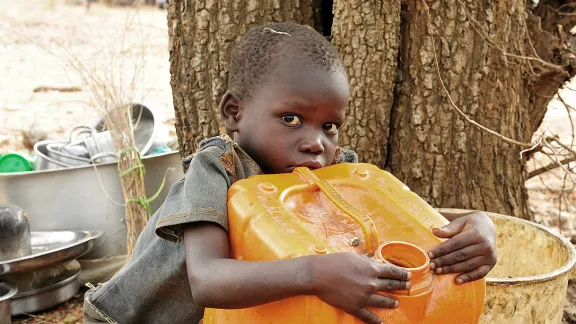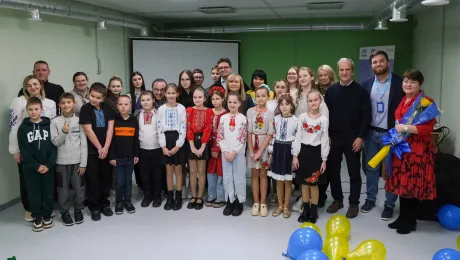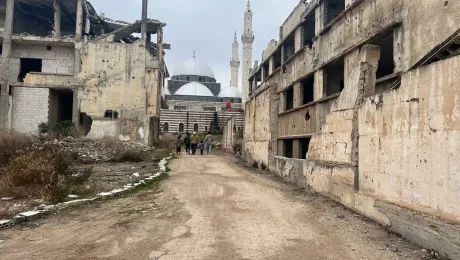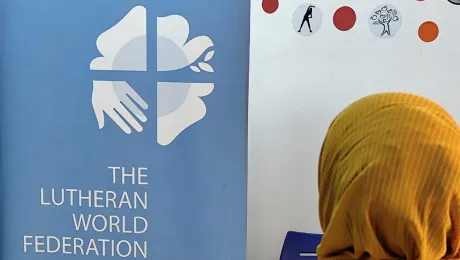
Ninety percent of the refugees are women and children. Photo: LWF/C. Kästner
(LWI) – “This is the largest refugee crisis in Africa, and the third largest in the world. How many thousands have to come, how many people have to die until the international community wakes up?” – Jesse Kamstra, country representative of The Lutheran World Federation (LWF) in Uganda, asks angrily.
For months his team and staff from partner organizations has been handling the influx of South Sudanese refugees into Northern Uganda, at peak times up to 6,000 people a day. “The numbers are overwhelming. It is a challenge for any humanitarian organization to meet the minimum humanitarian standards, but we are not willing to compromise on that,” Kamstra says. “More resources are needed to provide the necessary shelter, water, sanitation and protection to those fleeing the violence in South Sudan.”

Out of the 752,000 people who have fled from South Sudan to Uganda, more than 350,000 are being supported by LWF. The newest refugee camp, Palorinya, originally designed for 50,000 people, currently holds more than 135,000. New refugee camps are being opened all across Northern Uganda.
Water supply has become a challenge, with water trucks supporting the water supply additional to a network of boreholes recently drilled by LWF and other organizations. Assessment Capacities Project (ACAP) health statistics cite that six children have died in the past month due to poor health care. The biggest worry of Kamstra and his team however is the rainy season, which will start in a few weeks time. “ We need to get people settled before the rain starts, otherwise it will be a disaster,” he says.

The collection points in Lefori and Palorinya refugee camp give but a glimpse of what Kamstra is talking about. Groups of women, children and elderly stand in lines for registration with the local authorities, who grant every new arrival a refugee status. “We have been walking for five days,” a mother says. She arrived with three children, none of them older than six years, and a baby strapped on her back. Bundles of cooking equipment and clothing are nearby.
Our feet were swollen, my children and I were thirsty and hungry but, we couldn’t go back because walking to safety was our only option.I wanted my children to grow up in a safe environment, away from the sound of gun shots. I wanted to raise Dia and his five siblings in peace.
Like the other refugees this week, the family comes from the South Sudanese town of Kajo-Keji, a strategic point to control Juba road. In the past weeks this area has seen heavy fighting, the refugees tell of atrocities and the threat that the same would happen to them if they did not leave within a week. Others flee the developing famine in South Sudan, as the fighting has reached the Equatoria region, known as the breadbasket of the country.

The refugees have moved their entire households – on bicycles, motorcycles and their heads they carry mattresses, blankets, cooking pots, chicken and goats across the border. “There is nobody left in Kajo-Keji,” an old man says. “Everyone who was able to has fled.”
On the Ugandan side of the border, the refugees are received in collection centers where they are registered as refugees, vaccinated and given emergency food rations.

At a special desk LWF takes note of people with vulnerabilities: elderly, pregnant women, families, survivors of gender-based violence and children who are travelling alone. A blue wrist band marks them for the reception of special relief goods and follow up by the LWF protection unit. After, they are being shuttled to Palorinya refugee camp, where they will be allocated a plot to build a hut and settle for the time being.

LWF staff has been working without a break since early December, when the fighting in South Sudan got worse and the numbers started to rise. “They are incredible, I am so grateful for their hard work and dedication,” says Julius Kibet, LWF team leader in the Moyo field office that administers the LWF operation in Palorinya. "But the number of staff is limited, the supply of core relief items is delayed and we need more water supply systems and sanitation facilities," Kibet adds.

Out of the 752,000 people who fled from South Sudan to Uganda , more than 350,000 are being supported by LWF. The newest refugee camp, Palorinya, originally designed for 50,000 people, currently holds more than 135,000.

The absence of middle-aged men is striking, 89 percent of the refugees are women and children. Their fathers, brothers and uncles have been abducted or killed, they say. Betty Faiza, 36, clutches her newborn son she gave birth to on the road, five days ago. The child is named “Asante Dia” – Suaheli for “Thank you” and “Fatherless”. The child will never meet his father. “I have just lost my husband to the war and here I am blessed with a baby as precious as he was,’’ Faiza says.

Her situation however is an indicator for how far resources in Northern Uganda are stretched at the moment. Although LWF managed to eventually take the family to a shelter in the reception center and refer the mother and her son for post-natal care, Faiza as well as another new mother in her situation spent three nights in the open, with only a few blankets to wrap the infant in. Like hundreds of other refugees, they were waiting to be allocated a plot in Palorinya refugee camp to settle temporarily. The local authorities were simply too overwhelmed to take care of everyone on the same day.

Faiza does not complain. For three days, the heavily pregnant mother had walked with her kitchen equipment on her head, holding the hands of her two youngest children, Emma (6) and Peter (9) and trying to keep an eye on the three older ones. She is just happy to have finally arrived.
The family spent days without food. "Our feet were swollen, my children and I were thirsty and hungry but, we couldn’t go back because walking to safety was our only option,’’ Faiza says. She knew that chances of going into labor in the bush were high, but started the dangerous journey anyway. “I wanted my children to grow up in a safe environment, away from the sound of gun shots,” she says. “I wanted to raise Dia and his five siblings in peace.”
Text and photos by Cornelia Kästner, LWF communications


